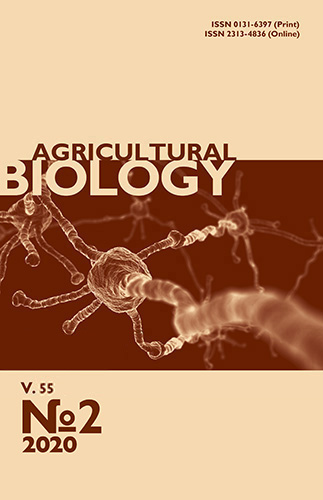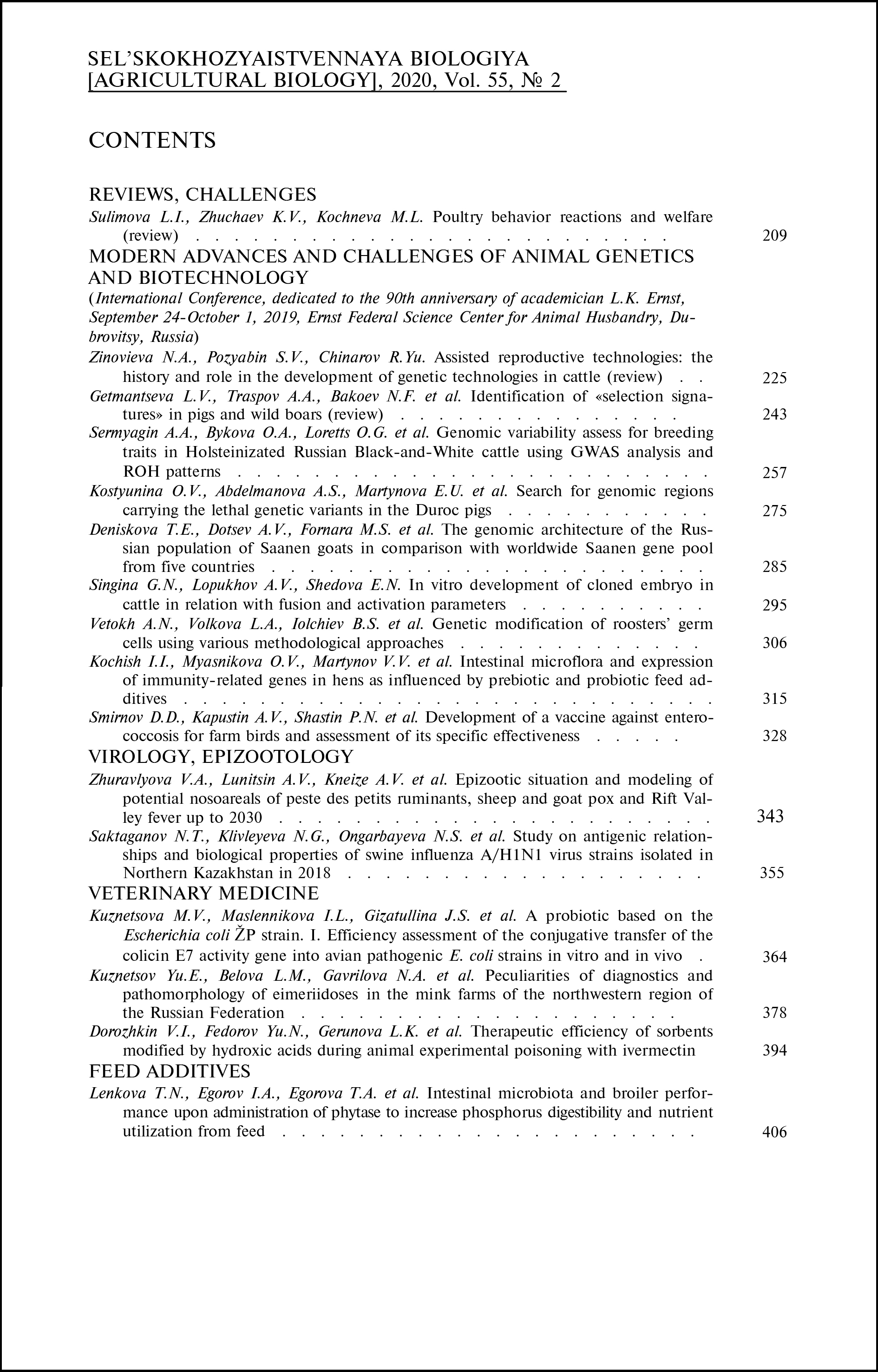doi: 10.15389/agrobiology.2020.2.394eng
UDC: 619:57.084.1:615.9:615.279
Acknowledgements:
The work was done according to CNCT FRC Boreskov Institute of Catalysis SB RAS state assignment as per RAS Fundamental Research Program for 2013-2020 (V.45, project V.45.2.8, EGISU R&D Reg. No, AAAA-A19-119050790074-9)
THERAPEUTIC EFFICIENCY OF SORBENTS MODIFIED BY HYDROXIC ACIDS DURING ANIMAL EXPERIMENTAL POISONING WITH IVERMECTIN
V.I. Dorozhkin1, Yu.N. Fedorov2, L.K. Gerunova3, L.G. P’yanova4, T.V. Gerunov3, M.S. Delyagina4, A.A. Tarasenko3
1All-Russian Research Institute of Sanitary, Hygiene and Ecology, 5, Zvenigorodskoe sh., Moscow, 123022 Russia, e-mail tox.dor@mail.ru (✉ corresponding author);
2All-Russian Research and Technological Institute of Biological Industry, 17, pos. Biokombinata, Shchelkovskii Region, Moscow Province, 141142 Russia, e-mail fun181@mail.ru;
3Stolypin Omsk State Agricultural University, 1, Institutskaya pl., Omsk, 644008 Russia, e-mail lk.gerunova@omgau.org, vsed@mail.ru, tarasenko_pharm@mail.ru;
4Center of New Chemical Technologies of the Federal Research Center Boreskov Institute of Catalysis, Siberian Branch RAS, 54, ul. Neftezavodskaya, Omsk, 644040 Russia, e-mail medugli@ihcp.ru
ORCID:
Dorozhkin V.I. orcid.org/0000-0003-1188-4449
Gerunov T.V. orcid.org/0000-0002-5594-2666
Fedorov Yu.N. orcid.org/0000-0001-7268-3734
Delyagina M.S. orcid.org/0000-0003-2846-8628
Gerunova L.K. orcid.org/0000-0003-0835-9352
Tarasenko A.A. orcid.org/0000-0001-7314-9998
P’yanova L.G. orcid.org/0000-0002-6207-0878
Received December 20, 2019
The development of modified sorbents combining the adsorption properties of the initial porous material and the biological activity of the modifiers is a сurrent issue of sorption therapy. The purpose of the study was to develop a method for modifying carbon sorbents with hydroxyacids and to conduct a comparative assessment of their effectiveness upon poisoning animals with ivermectin. A granular carbon enterosorbent with a specific surface area of 300-400 m2/g was the matrix for the preparation of biospecific sorbents, glycolic acid (50 wt.%, manufactured by Merk Schuchardt OHG, Germany) and lactic acid (80 wt.%, produced by MOSREACTIVE, Russia) and a copolymer thereof were used as modifiers. To study the morphology and surface topography of the obtained samples, scanning electron microscopy (JSM 6460LV, JEOL Ltd, Japan) was used. The therapeutic efficacy of the modified sorbents was measured in 5 groups (10 animals each) of outbred adult white rats weighing 180-200 g. During 5 days animals of different groups received one of the modified sorbents in doses of 0.3 g/kg upon acute intoxication with Baymec® (1 % solution of ivermectin, Bayer Animal Health GmbH, Germany; manufactured by Federal Centre for Animal Health, Russia). The controls were intact and intoxicated animals. At the end of the experiment, blood was taken from all animals for biochemical studies, as well as histological examination of organs and tissues was performed post mortem. Electron microscopic examination showed that upon modification, the size and shape of the granules of the initial sorbent are preserved, but surface topography and morphology change. The results of in vivo experiments showed varying degrees of efficiency of enterosorption in rats when modified sorbents were applied to the animals intoxicated with ivermectin-containing Baymec® preparation. Creatinine varied from 40.86±0.66 μmol/l (p < 0.0001) for the sorbent with lactic acid to 82.32±2.74 μmol/l (p = 0.4698) for the sorbent with glycolic acid; in intoxicated animals, the creatinine level reached 87.00±5.52 μmol/l, p < 0.0001). Intoxication was accompanied by an increase in the total protein content in blood of rats (73.08±0.96 g/l, р = 0.0001), mainly due to globulins. At the same time, the concentration of urea decreased (2.44±0.05 mmol/l, р = 0.0001) but the content of total bilirubin increased (1.80±0.07 μmol/l, р = 0.0379), while the level of creatinine increased 2.3 times compared to intact animals. Post-mortem analysis indicated the polytropic nature of the drug. In animals, acute congestive hyperemia of the internal organs and the brain was found. Under the epicardium, petechial hemorrhages were noticeable. There were also marked the heart dilatation, granular dystrophy of cardiomyocytes, protein-fatty degeneration of the liver, emphysematous changes in the lungs, congestive hyperemia and hemorrhages in the kidneys. In the gastrointestinal tract signs of acute catarrh were prevailing. The most distinct corrective effect of enterosorption was noted when using a sorbent modified with lactic acid oligomer. The research results confirm the prospects for the development of bifunctional sorbents as well as expand the possibilities of sorption therapy.
Keywords: ivermectin, Baymec®, modified enterosorbents, hydroxyacids, lactic acid, glycolic acid, clinical pathology, blood biochemistry, histopathology, intoxication, sorbent therapy.
REFERENCES
- Klimenko N.A. Khimiya i tekhnologiya vody, 2008, 5(30): 478-489 (in Russ.).
- Sidorchuk V.V. Zhurnal prikladnoi khimii, 2006, 9(79): 1444-1447 (in Russ.).
- Mykola S. Surface functional groups of carbons and the effects of their chemical character, density and accessibility to ions on electrochemical performance. Carbon, 2008, 46: 1475-1488 CrossRef
- Tasis D. Chemistry of carbon nanotubes. Chemical Reviews 2006, 106: 1105-1136 CrossRef
- Bazula P.A. Surface and pore structure modification of ordered mesoporous carbons via a chemical — oxidation approach. Microporous and Mesoporous Materials, 2008, 108: 266-275 CrossRef
- Hiromi K., Tachimoto K., Anraku Y. Functionalization of single-walled carbon nanotube by the covalent modification with polymer chains. Journal of Colloid and Interface Science, 2007, 306: 28-33 CrossRef
- Jianfeng Sh. Thermo-physical properties of epoxy nanocomposites reinforced with amino-functionalized multi-walled carbon nanotubes. Composites: Part A, 2007, 38: 1331-1336 CrossRef
- Niu L., Yanling L., Zhanqing L. A highly selective chemical gas sensor based on functionalization of multi-walled carbon nanotubes with poly(ethylene glycol). Sensors and Actuators B, 2007, 126: 361-367 CrossRef
- Qiao Ch., Xu R., Yu D. Multiwalled carbon nanotube/polybenzoxazine nanocomposites: preparation, characterization and properties. Polymer, 2006, 47: 7711-7719 CrossRef
- Ozdil D., Aydin H.M. Polymers for medical and tissue engineering applications. Journal of Chemical Technology and Biotechnology, 2014, 89: 1793-1810 CrossRef
- Botvin V., Pozdniakov M., Filimoshkin A. Intermolecular “zipper” type depolymerization of oligomeric molecules of lactic and glycolic acids prepacked as paired associates. Polymer Degradation and Stability, 2017, 146: 126-131 CrossRef
- Swider E., Koshkina O., Tel J., Cruz L.J., de Vries I.J.M., Srinivas M. Customizing poly(lactic-co-glycolic acid) particles for biomedical applications. Acta Biomaterialia, 2018, 73: 38-51 CrossRef
- Kasirajan S., Umapathy D., Chandramohan Ch., Aafrin V., Jenitapeter M., Udhyasooriyan L., Packirisamy A.S.B., Muthusamy S. Preparation of poly(lactic acid) from Prosopis juliflora and incorporation of chitosan for packaging applications. Journal of Bioscience and Bioengineering, 2019, 128(3): 323-331 CrossRef
- Lee J.C., Choi M.-C., Choi D.-H., Ha C.-S. Toughness enhancement of poly(lactic acid) through hybridisation with epoxide-functionalised silane via reactive extrusion. Polymer Degradation and Stability, 2019, 160: 195-202 CrossRef
- Meshcheryakova O.V., Churova M.V., Nemova N.N. V sbornike: Ekologicheskiya fiziologiya i biokhimiya vodnykh organizmov [Ecophysiology and biochemistry of aquatic organisms]. Petrozavodsk, 2010: 163-171 (in Russ.).
- Burgos N., Tolaguera D., Jime’nez S.F.A. Synthesis and characterization of lactic acid oligomers: evaluation of performance as poly (lactic acid) plasticizers. Journal of Polymers and the Environment, 2014, 22: 227-235 CrossRef
- Boomsma B., Bikker E., Lansdaal E., Stuut P. L-Lactic acid — a safe antimicrobial for home- and personal care formulations. SOFWournal, 2015, 141(10): 2-5.
- Wang C., Chang T., Yang H., Cui M. Antibacterial mechanism of lactic acid on physiological and morphological properties of Salmonella enteritidis, Escherichia coli and Listeria monocytogenes. Food Control, 2015, 47: 231-236 CrossRef
- Maharramov A.M., Ramazanov M.A., Hasanova U.A. Nanostructures for antimicrobial therapy — the modern trends in the treatment of bacterial infections. In: Antimicrobial nanoarchitectonics. From synthesis to applications. A.M. Grumezescu (ed.). Elsevier, 2017: 445-473 CrossRef
- Merkulov G.A. Kurs patologicheskoi tekhniki [Pathological techniques]. Leningrad, 1979 (in Russ.).
- Kononskii A.I. Gistokhimiya [Histochemistry]. Kiev, 1976 (in Russ.).
- Alekseev K.V., Alyautdin R.N., Blynskaya E.V., Kvinkh B.T. Vestnik novykh meditsinskikh tekhnologii, 2009, 16(2): 142-145 (in Russ.).
- Shtil'man M.I. Polimery mediko-biologicheskogo naznacheniya [Biomedical polymers]. Moscow, 2006 (in Russ.).
- Kuznetsova I.G., Severin S.E. Razrabotka i registratsiya lekarstvennykh sredstv, 2013, 4(5): 30-36 (in Russ.).
- Shkarin A.A., Yarkova A.V., Pokharukova Yu.E., Novikov V.T. Vestnik Tomskogo gosudarstvennogo universiteta, 2014, 385: 224-226 (in Russ.).
- Wolstenholme A.J. Glutamate-gated chloride channels. Journal of Biological Chemistry,2012, 287: 40232-40238 CrossRef
- Bai S.H., Ogbourne S. Eco-toxicological effects of the avermectin family with a focus on abamectin and ivermectin. Chemosphere, 2016, 154: 204-214 CrossRef
- Zhang Y., Luo M., Xu W., Yang M., Wang B., Gao J., Li Y., Tao L. Avermectin confers its cytotoxic effects by inducing DNA damage and mitochondria-associated apoptosis. Journal of Agricultural and Food Chemistry, 2016, 64: 6895-6902 CrossRef
- Chudov I.V., Ismagilova A.F. Agrarnyi vestnik Urala, 2012, 5(97): 53-57 (in Russ.).
- Sulaimanova G.V., Donkova N.V. Vestnik KrasGAU,2015, 10(109): 201-205 (in Russ.).
- Sorokin A.V., Mashoshina D.O., Dragovoz I.S., Molokoedov V.V. Mezhdunarodnyi studencheskii nauchnyi vestnik, 2018, 4-1: 98-100 (in Russ.).
- Sparsa A., Bonnetblanc J.M., Peyrot I., Loustaud-Ratti V., Vidal E., Bédane C. Systemic adverse reactions with ivermectin treatment of scabies. Annales de Dermatologie et de Vénéréologie, 2006, 133(10): 784-787.
- Campbell W.C. History of avermectin and ivermectin, with notes on the history of other macrocyclic lactone antiparasitic agents. Current Pharmaceutical Biotechnology, 2012, 13(6): 853-865 CrossRef












